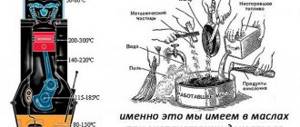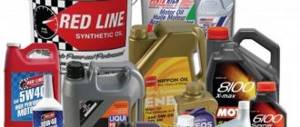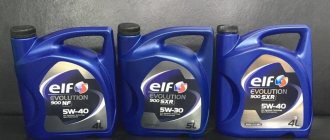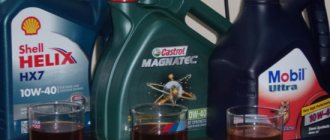The debate among motorists on this issue is endless. They become worse when the seasons change between winter and summer. Which oil should I fill in for the winter, 5W30 or 5W40? This topic is especially of concern to car owners who have a long engine life. The loads on it, depending on the ambient temperature, are different. Manufacturers take this point into account. And in this situation, it is important to use the oil recommended by the developer. If this is not possible or you want another option, then you need to study their properties.
Features of engine operation in winter
The determining factor in the selection of oil when operating the engine in the cold season is the air temperature. At low values, the lubricant becomes thicker and it is often difficult for the owner to start the car after night frosts. Many people try to protect the battery from frost and do not pay attention to the oil. However, when oil not intended for low temperatures is poured in, it becomes viscous and prevents the crankshaft from turning during startup, even with a full battery capacity. If cold weather sets in, and the frequency of engine oil changes allows you to drive the old one, you should still think about replacing it. How do you know if engine lubrication is appropriate for the season? You must carefully read the information on the canister.
Comparison and definition of 5w30 and 5w40
Oil viscosity.
5w30 is a motor oil used to lubricate automobile engines. Its designation contains two numbers that display the main properties of lubricants: viscosity level at high and low temperatures.
In order for the engine to be started in cold weather, the liquid must not be too viscous. But the summer one is different in that it must retain a lubricating film well between the elements.
The first number indicates the class of application, the second is an indicator of use in the summer. This means that this liquid is all-season.
5w40 oil is also considered all-season, its winter use class is 5w, and its highest temperature rating is 40. This designation was adopted by the SAE specification and is considered an international standard defining the viscosity level of engine lubricants.
When determining the quality of a liquid, you should first of all pay attention to the characteristics of its viscosity and temperature.
API oil classification.
Engine lubricants contain base oils and various additives that add thickness to them. With these additives you can achieve the desired effect in summer or winter. But now more and more car owners want to simplify their lives and use special all-season fluids. The quality and quantity of thickening additives affects the viscosity of the finished mixture. Additionally, multipurpose fluids can change viscosity levels depending on shear rate. If the speed is low, then the viscosity is quite high.
Modern lubricants differ in the amount of thickening additives. That is why the second number, indicating the level of viscosity at elevated temperatures, is different. 30 and 40 show how long the lubricant can maintain a protective film in summer at high temperatures. This property is of great importance for maintaining engine performance and reducing the likelihood of premature wear. In addition, it does not allow the engine to stop in hot weather if the car is in a traffic jam.
What does the marking hide?
The abbreviation on the oil container contains designations, for example, “5W30”. The numbers indicate the lower and upper temperature limits within which the declared properties will be guaranteed. For example, the definition of 5W30 and 5W40 oil is as follows.
- 5W30. The number “5” means that the oil will retain its lubricating properties at temperatures down to -35C° without loss. The number “30” is up to +30 C°.
- 5W40. The range will be from −30 to +35С°.
The English W in the marking means winter. Why is there a different threshold for lower temperatures at 5W? This is due to the optimization of the performance of the additives present in each oil. This standard was introduced by SAE (American Association of Automotive Engineers).
What is the difference between 5W30 or 5W40 oils for winter use
Many motorists mistakenly believe that the performance characteristics of oil in winter are affected solely by the part of the SAE index responsible for winter properties.
This is why they make the wrong conclusion: you can fill the engine with any of the oils in question in the winter, if the temperature in the region allows.
The so-called summer part of the index (in fact, indicating the operating viscosity at a temperature of 100 °C, which is approximately the same in both summer and winter) also affects the performance of the lubricant in the cold season.
Viscosity difference between 5W40 and 5W30
And here, first of all, you need to know the car manufacturer’s requirements for oil. If the documentation for the car indicates that you need to pour lubricant with the summer index SAE 40, pour this oil. If SAE 30 - accordingly, select a lubricant with a viscosity of SAE 5W30.
There are slight deviations from the rules here. If the engine already has a good mileage, and you live in a region with amplitude fluctuations in annual temperature (cold in winter, hot in summer), it is better to take a thicker lubricant according to the summer index.
Example of the difference between 5w30 and 5w40 oil
That is, in winter it is better to pour SAE 5W40, since it may turn out that you will have to drive for a long time on the oil filled in before winter. A thicker lubricant for a motor with wear, due to increased gaps in the friction pairs, is preferable.
What are the differences between oils?
What is the difference between 5W30 and 5W40? It's not big. Both are all-season, the difference in temperature range is 5°C. However, for starting the engine in cold weather this difference is significant. If the viscosity of the oil corresponds to the “overboard” temperature, it will remain the same as, for example, at 0C°. And if it doesn’t match, the oil will thicken and it will be difficult to turn the engine. In general, 5W40 is more viscous.
Synthetic or semi-synthetic
The question may arise: “What is the difference between 5W30 and 5W40, synthetics and semi-synthetics? The main thing is what the base consists of. In semi-synthetic oil, the base can be organic, and the additive composition is artificial. Among advanced motorists, it is believed that semi-synthetic oils provide a thicker working film and are better used in high-mileage engines that have pressure problems. It is also important that semi-synthetics are cheaper than synthetics. The difference in price, depending on the manufacturer, can reach up to 1000 rubles. for a 5 liter canister.
Classification of motor oils
When entering a car store, any car owner is faced with a choice of different oils not only by manufacturer, but also by their classification. Less experienced car owners are baffled by such questions from consultants, because they do not particularly understand the markings indicated on the lubricant container. First of all, when buying a new or used car, it is important to find out what kind of oil is recommended to be poured into its engine. It comes in several types:
- Mineral.
- Semi-synthetic.
- Synthetic.
The first type is used in cars with less demanding and easy-to-use engines. These are mainly classic Lada cars or their younger brothers in the family, but with mileage. This oil has a coarser composition and must be replaced more frequently.
The second type is a kind of universal oil that is suitable for use on classic cars or on other models of the domestic automobile industry. However, some budget foreign cars or new cars of the AvtoVAZ concern are also filled with semi-synthetics. In the price segment, it is more affordable if you choose from high-quality oils; of course, it is more expensive than mineral oil, but it can be changed at about 10 thousand kilometers.
The third type , synthetic oil, is already more expensive, but it is also noticeably better than the previous ones in its composition, properties and parameters. It contains a larger number of special additives and additives that improve engine response and protect it more reliably.
Having made a confident choice in favor of one of these types, you need to choose the appropriate labeling.
All oils are labeled according to a special classification system established by the American Automobile Manufacturers Union. Based on it, all oils were divided into three categories according to seasonal characteristics, which give an understanding of where to choose, guided by the region of residence. These are the following categories:
- summer;
- winter;
- all-season oil.
From the names it is clear that each of them is selected based on the season. The third type of oil has special additives that make it suitable for use at different times of the year. However, a debate constantly arises about which oil is suitable for the winter in the realities of the Russian climate - 5W30 or 5W40.
Video: Viscosity additives for motor oils
Viscosity
With significantly similar characteristics, the main difference between 5W30 and 5W40 oil is thickness. 5W30 is less viscous at low temperatures, which is good for engine starting. Oil of this SAE marking has become the standard for all modern cars whose engines are not subject to forced loads. 5W40 is more preferable for cars that operate in southern regions, where temperatures are high in summer and there is a danger of lubricant dilution and loss of its properties.
Other characteristics
In terms of other main indicators, the oils are comparable. There are small differences, for example, in ash content, but a motorist who does not understand such terms will not be able to understand how 5W40 oil differs from 5W30. Moreover, these differences are present in identical products with the same labeling, only from different brands.
Engine operating principle
Alas, not all car owners and drivers think about how the engine of their vehicle works. But this is the heart of the machine, and it requires proper care and handling, just like a full-fledged organ of the human body. The main component that drives a car is the internal combustion engine. Thanks to this device, travel and comfortable movement over long distances became available to humanity. Recently, a car has become something less than a luxury and is affordable for so many people.
Of course, they made life much easier for everyone without exception. Nowadays it is impossible to imagine a person without cars, as well as without cell phones. They have become assistants in everything from taxis and public transport to ambulances, fire protection and other emergency services. Even delivering groceries to a convenience store, which makes life much easier, is done with the help of machines.
Of course, this does not oblige everyone around to know the structure and operating principle of the engine. However, understanding the principle of its operation, it will be easier to take measures for the care and maintenance of this unit. The engine pistons are driven by a micro-explosion of the fuel mixture in the combustion chamber. The downward moving pistons rotate the crankshaft. All this driving force transmits torque to the transmission, and then to the wheels. This is the simplest and most meaningful explanation of the operation of an internal combustion engine, from which we can conclude that there are a large number of parts exposed to high temperatures, loads and friction.
All engine parts needed to be protected from this, so engineers created a lubrication system that supplies lubricant to friction points. The oil pump, which is driven together with the starter, is responsible for supplying lubricant. It pushes the lubricant along special lines to the lubrication points.
Thus, it should be clear that motor oils protect the engine from overheating, together with the engine cooling system, protect it from wear due to friction, and also clean the working surfaces.
Additives
Advertising often offers miracle additives that can increase viscosity and improve engine performance, for example, making it easier to start at low temperatures. Sometimes it makes sense to use them, but we must not forget that the manufacturer has already supplied all synthetic and semi-synthetic oils with an additive package. If problems arise, for example, the sound of the engine has changed, and there is a suspicion that the reason is in the lubrication, then it is more advisable to check whether the product meets the characteristics of a particular engine.











